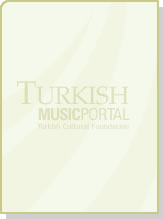
ARTICLES
EVTERPI: OTTOMAN CLASSICAL MUSIC OF THE EARLY 19TH CENTURY IN BYZANTINE NEUMES
( by Dr.mehmet Ali Sanlıkol )
Dr.Mehmet Ali Sanlıkol
Most musical traditions within the greater Ottoman cultural zone have used oral tradition as their principal method of learning and teaching up until the 20th century. It is possible to say that the one major exception was the neumatic notation system of Byzantine church music which was used to preserve the sacred liturgy of GreekOrthodoxy. Byzantine notation was also used for preserving secular music as early as the 15th century and the first printed collection of hundreds of Ottoman classical vocal music pieces in Byzantine notation, entitled Evterpi, was published in 1830. However, since mostly church cantors learn how to read Byzantine notation and they generally do not have an immediate interest in Ottoman secular music repertoire, these publications are still waiting to be transcribed into the current notation system used by Turkish classical music.
Musicological findings and data from Evterpi as well as related publications help shed light on the changes Ottoman classical music went through during the past couple of centuries. One such change seems to have taken place in the usul (rhythmic cycle) system of Ottoman/Turkish classical music. For example, today the only version of sofyan usul that is widely accepted is a 4-beat long rhythmic cycle which matches the descriptions given by Ali Ufki (1610-1675), Dimitri Kantemir (1673-1723), Charles Fonton (1725-1793) and others until the 19th century. However, in the early 19th century another sofyan usul, a 9-beat long rhythmic cycle, gained popularity and consistently appears in Evterpi as well as the subsequent publications mentioned earlier (short descriptions of this particular 9-beat long sofyan cycle are listed in at least four Ottoman/Turkish sources from this period as well). However, by the early 20th century the 9-beat long sofyan cycle seems to disappear completely. Interestingly enough, all of the pieces which were once assigned to the 9-beat long sofyan eventually came to be associated with aksak, another 9-beat long usul cycle which first surfaced in 1873.
While Evterpi helps us understand some of the changes Ottoman classical music went through during the past couple of centuries it also poses certain difficulties in the interpretation of the notation due to the cultural differences between Ottoman/Turkish classical music and Greek Orthodox church music. One of these difficulties arises in the context of the makam (modal) system of Ottoman classical music. Due to the varying number of microtones each tradition assigns to different modal entities it is impossible to come to concrete conclusions regarding tuning and musical temperaments of the period which were employed in the repertoire based on the notation presented in Evterpi.
Evterpi clearly occupies a special place in Ottoman/Turkish music studies. Although scholars such as Owen Wright have been able to locate few instrumental pieces which survived in the oral tradition since the 17th and 18th centuries, there are even fewer vocal pieces that have survived to this day. Through Evterpi and similar subsequent publications using Byzantine notation, for the first time we are able to study an extensive amount of Ottoman/Turkish classical vocal music compositions that can be dated to the 18th and 19th centuries and get a better understanding of the musical contributions and consequences of oral tradition. However, as we engage in this study it is important that we underestimate neither the cultural differences between Ottoman/Turkish classical and Greek Orthodox church music nor their deep links and mutual influences. It is the unique contribution of Evterpi and other such publications that provide evidence of both.

